Enhancement of Groundwater Recharge from Wadi Al Bih Dam, UAE
Abstract
:1. Introduction
- Develop a local-scale GIS-based groundwater budget model (GWBM) for the Wadi Al Bih area to determine the available groundwater resources;
- Estimate the other sources of groundwater recharge, such as internal flow and return flow;
- Determine the influence of rainfall, temperature, and potential evaporation on total groundwater storage in the Wadi Al Bih area.
2. Materials and Methods
2.1. Site Description
2.1.1. Location
2.1.2. Geological Setting
- Ghail Formation (blue color in Figure 4): The age is Triassic. The environment of deposition is thought to be in the tidal zone, conforming to dolomite deposition in the present-day sabkhas in the Emirates. The formation consists of a thick fractured dolomitized limestone and represents the upper layer of the deep aquifer.
- Hagil Formation (light green color in Figure 4): The Hagil Formation agreeably overlies the Bih formations having lithology of light-colored, fine-grained argillaceous.
- Limestone with shale separations and sporadic shale beds, dolomitized limestone, and slight oolitic limestones. This formation age ranges from the late Permian to the Early Triassic. From the structural point of view, the eastward-dipping dolomite close to the main dams constitutes some eastern limb portions of the anticline, which plummets to the south [11,13].
2.1.3. Hydrogeological Setting
2.2. Data Collection
2.3. Variogram Testing
2.4. Water Budget Model
2.5. Groundwater Recharge Estimation
2.5.1. Water Table Fluctuation Method
2.5.2. Potential Method
2.5.3. Estimation of Return Flow from Irrigation
2.6. Effect of Climate-Related Variables on Total Groundwater Storage
2.7. Water Security
- Calculation of the fraction of freshwater withdrawal from the renewable water available (not including desalinated water or treated wastewater) using the following equation:
- 2.
- Calculation of water overuse, derived by subtracting the target use fraction of 0.4 from the freshwater fraction.
- 3.
- Calculation of the overuse weight as a fraction of freshwater withdrawal from the total water withdrawals.
- 4.
- Calculation of weighted overuse (final WSI indicator) as a product of water overuse and overuse weight.
3. Results and Discussion
3.1. Status of Groundwater Resources
3.2. Groundwater Storage
3.3. Effect of Climate Variables on Groundwater Storage under a Changing Climate
3.4. Water Security
4. Conclusions
Author Contributions
Funding
Institutional Review Board Statement
Informed Consent Statement
Data Availability Statement
Acknowledgments
Conflicts of Interest
References
- AGEDI. Final Technical: Regional Desalination and Climate Change; Local, National and Regional Climate Change Programme, CCRG/IO; AGEDI: Milano, Italy, 2016. [Google Scholar]
- Sherif, M.; Ebraheem, A.; Shetty, A. Groundwater recharge from dams in United Arab Emirates. In World Environmental and Water Resources Congress 2017; American Society of Civil Engineers: Reston, VI, USA, 2017. [Google Scholar]
- Sherif, M.; Sefelnasr, A.; Ebraheem, A.A.; Al Mulla, M.; Alzaabi, M.; Alghafli, K. Spatial and Temporal Changes of Groundwater Storage in the Quaternary Aquifer, UAE. Water 2021, 13, 864. [Google Scholar] [CrossRef]
- Beniston, M. Climatic change in mountain regions: A review of possible impacts. In Climate Variability and Change in High Elevation Regions: Past, Present & Future; Springer: Berlin/Heidelberg, Germany, 2003; pp. 5–31. [Google Scholar]
- Patz, J.; Corvalan, C.; Horwitz, P.; Campbell-Lendrum, D.; Watts, N.; Maiero, M.; Olson, S.; Hales, J.; Miller, C.; Campbell, K.; et al. Our Planet, Our Health, Our Future. Human Health and the Rio Conventions: Biological Diversity, Climate Change and Desertification; World Health Organization: Geneva, Switzerland, 2012. [Google Scholar]
- Mfarrej, M.F.B. Climate change patterns in the UAE: A qualitative research and review. Nat. Environ. Pollut. Technol. 2019, 18, 261–268. [Google Scholar]
- Sherif, M.; Almulla, M.; Shetty, A.; Chowdhury, R.K. Analysis of rainfall, PMP and drought in the United Arab Emirates. Int. J. Climatol. 2014, 34, 1318–1328. [Google Scholar] [CrossRef]
- Sherif, M.; Akram, S.; Shetty, A. Rainfall analysis for the northern wadis of United Arab Emirates: A case study. J. Hydrol. Eng. 2009, 14, 535–544. [Google Scholar] [CrossRef] [Green Version]
- AGEDI. Regional Atmospheric Modelling for the Arabian Gulf Region—Future Scenarios and Capacity Building; Local, National and Regional Climate Change Programme; AGEDI: Milano, Italy, 2015; Available online: https://www.researchgate.net/publication/299234015_Technical_Report_Regional_Downscaled_Climate_Change_Atmospheric_Modeling_Results (accessed on 28 August 2022).
- Patz, J.A.; Grabow, M.L.; Limaye, V.S. When it rains, it pours: Future climate extremes and health. Ann. Glob. Health 2014, 80, 332–344. [Google Scholar] [CrossRef] [Green Version]
- Ebraheem, A.M.; Sherif, M.M.; Al Mulla, M.M.; Akram, S.F.; Shetty, A.V. A geoelectrical and hydrogeological study for the assessment of groundwater resources in Wadi Al Bih, UAE. Environ. Earth Sci. 2012, 67, 845–857. [Google Scholar] [CrossRef]
- Ebraheem, A.M.; Al Mulla, M.M.; Sherif, M.M.; Awad, O.; Akram, S.F.; Al Suweidi, N.B.; Shetty, A. Mapping groundwater conditions in different geological environments in the northern area of UAE using 2D earth resistivity imaging survey. Environ. Earth Sci. 2014, 72, 1599–1614. [Google Scholar] [CrossRef]
- Electrowatt, E. Wadi Bih dam and Groundwater Recharge Facilities; Internal Report; 1981; Available online: https://scholar.google.com.hk/scholar?hl=zh-CN&as_sdt=0%2C5&q=Wadi+Bih+dam+and+Groundwater+Recharge+Facilities&btnG= (accessed on 20 October 2022).
- Halcrow, S. Trucial States Council. Report on the Water Resources of the Trucial States; Engineering Report for the Trucial States Council; Water Resources Survey; Ministry of Agriculture and Fisheries: Dubai, United Arab Emirates, 1969. [Google Scholar]
- IWACO; Study, G. Drilling of Deep-Water Wells at Various Locations in the UAE; Ministry of Environment and Water: Dubai, United Arab Emirates, 1986. [Google Scholar]
- Elasha, B.O. Mapping of climate change threats and human development impacts in the Arab region. In UNDP Arab Development Report–Research Paper Series; UNDP Regiona Bureau for the Arab States: Amman, Jordan, 2010. [Google Scholar]
- Martens, B.; Miralles, D.G.; Lievens, H.; van der Schalie, R.; de Jeu, R.A.; Fernández-Prieto, D.; Beck, H.E.; Dorigo, W.A.; Verhoest, N.E. GLEAM v3: Satellite-based land evaporation and root-zone soil moisture. Geosci. Model Dev. 2017, 10, 1903–1925. [Google Scholar] [CrossRef] [Green Version]
- Crosbie, R.S.; McCallum, J.L.; Harrington, G.A. Estimation of groundwater recharge and discharge across northern Australia. In Proceedings of the 18th World IMACS Congress and MODSIM09 International Congress on Modelling and Simulation, Cairns, Australia, 13–17 July 2009. [Google Scholar]
- Sharda, V.N.; Kurothe, R.S.; Sena, D.R.; Pande, V.C.; Tiwari, S.P. Estimation of groundwater recharge from water storage structures in a semi-arid climate of India. J. Hydrol. 2006, 329, 224–243. [Google Scholar] [CrossRef]
- Zghibi, A.; Mirchi, A.; Msaddek, M.H.; Merzougui, A.; Zouhri, L.; Taupin, J.D.; Chekirbane, A.; Chenini, I.; Tarhouni, J. Using analytical hierarchy process and multi-influencing factors to map groundwater recharge zones in a semi-arid Mediterranean coastal aquifer. Water 2020, 12, 2525. [Google Scholar] [CrossRef]
- Van Vliet, M.T.; Jones, E.R.; Flörke, M.; Franssen, W.H.; Hanasaki, N.; Wada, Y.; Yearsley, J.R. Global water scarcity including surface water quality and expansions of clean water technologies. Environ. Res. Lett. 2021, 16, 024020. [Google Scholar] [CrossRef]
- Sophocleous, M. Groundwater recharge estimation and regionalization: The Great Bend Prairie of central Kansas and its recharge statistics. J. Hydrol. 1992, 137, 113–140. [Google Scholar] [CrossRef]
- Moon, S.-K.; Woo, N.C.; Lee, K.S. Statistical analysis of hydrographs and water-table fluctuation to estimate groundwater recharge. J. Hydrol. 2004, 292, 198–209. [Google Scholar] [CrossRef]
- Abijith, D.; Saravanan, S.; Singh, L.; Jennifer, J.J.; Saranya, T.; Parthasarathy, K.S. GIS-based multi-criteria analysis for identification of potential groundwater recharge zones-a case study from Ponnaniyaru watershed, Tamil Nadu, India. HydroResearch 2020, 3, 1–14. [Google Scholar] [CrossRef]
- Rohwer, J.; Gerten, D.; Lucht, W. Development of Functional Irrigation Types for Improved Global Crop Modelling; Potsdam-Institut fuer Klimafolgenforschung, e.V.: Potsdam, Germany, 2007. [Google Scholar]
- Sherif, M.M.; Ebraheem, A.M.; Al Mulla, M.M.; Shetty, A.V. New system for the assessment of annual groundwater recharge from rainfall in the United Arab Emirates. Environ. Earth Sci. 2018, 77, 412. [Google Scholar] [CrossRef]
- Al-Muaini, A.; Green, S.; Dakheel, A.; Abdullah, A.H.; Abou Dahr, W.A.; Dixon, S.; Kemp, P.; Clothier, B. Irrigation management with saline groundwater of a date palm cultivar in the hyper-arid United Arab Emirates. Agric. Water Manag. 2019, 211, 123–131. [Google Scholar] [CrossRef]
- Taylor, R.G.; Scanlon, B.; Döll, P.; Rodell, M.; van Beek, R.; Wada, Y.; Longuevergne, L.; Leblanc, M.; Famiglietti, J.S.; Edmunds, M.; et al. Ground water and climate change. Nat. Clim. Change 2013, 3, 322–329. [Google Scholar] [CrossRef] [Green Version]
- Cuthbert, M.O.; Taylor, R.G.; Favreau, G.; Todd, M.C.; Shamsudduha, M.; Villholth, K.G.; MacDonald, A.M.; Scanlon, B.R.; Kotchoni, D.O.; Vouillamoz, J.M.; et al. Observed controls on resilience of groundwater to climate variability in sub-Saharan Africa. Nature 2019, 572, 230–234. [Google Scholar]
- Hamed, K.H.; Rao, A.R. A modified Mann-Kendall trend test for autocorrelated data. J. Hydrol. 1998, 204, 182–196. [Google Scholar] [CrossRef]
- Hirsch, R.M. A perspective on nonstationarity and water management. JAWRA J. Am. Water Resour. Assoc. 2011, 47, 436–446. [Google Scholar] [CrossRef]
- Falkenmark, M. Meeting water requirements of an expanding world population. Philos. Trans. R. Soc. Lond. Ser. B Biol. Sci. 1997, 352, 929–936. [Google Scholar] [CrossRef] [Green Version]
- Falkenmark, M.; Berntell, A.; Jägerskog, A.; Lundqvist, J.; Matz, M.; Tropp, H. On the Verge of a New Water Scarcity: A Call for Good Governance and Hyman Ingenuity; Stockholm International Water Institute (SIWI): Stockholm, Sweden, 2007. [Google Scholar]
- Wada, Y.; van Beek, L.P.; Viviroli, D.; Dürr, H.H.; Weingartner, R.; Bierkens, M.F. Global monthly water stress: 2. Water demand and severity of water stress. Water Resour. Res. 2011, 47. [Google Scholar] [CrossRef]
- United Nations. Comprehensive Assessment of the Freshwater Resources of the World; overview document; World Meteorological Organization: Geneva, Switzerland, 1997. [Google Scholar]
- Vorosmarty, C.J.; Green, P.; Salisbury, J.; Lammers, R.B. Global water resources: Vulnerability from climate change and population growth. Science 2000, 289, 284–288. [Google Scholar] [CrossRef] [PubMed] [Green Version]
- Wada, Y.; Gleeson, T.; Esnault, L. Wedge approach to water stress. Nat. Geosci. 2014, 7, 615–617. [Google Scholar] [CrossRef]
- Gain, A.K.; Giupponi, C.; Wada, Y. Measuring global water security towards sustainable development goals. Environ. Res. Lett. 2016, 11, 124015. [Google Scholar] [CrossRef]
- Wada, Y.; van Beek, L.P.; Sperna Weiland, F.C.; Chao, B.F.; Wu, Y.H.; Bierkens, M.F. Past and future contribution of global groundwater depletion to sea-level rise. Geophys. Res. Lett. 2012, 39. [Google Scholar] [CrossRef]
- Sherif, M.; Ebraheem, A.A.; Shetty, A.; Sefelnasr, A.; Alghafli, K.; Al Asam, M. Evaluation of the effect of the Wadi Bih dam on groundwater recharge, UAE. In Wadi Flash Floods; Springer: Berlin/Heidelberg, Germany, 2022; p. 509. [Google Scholar]
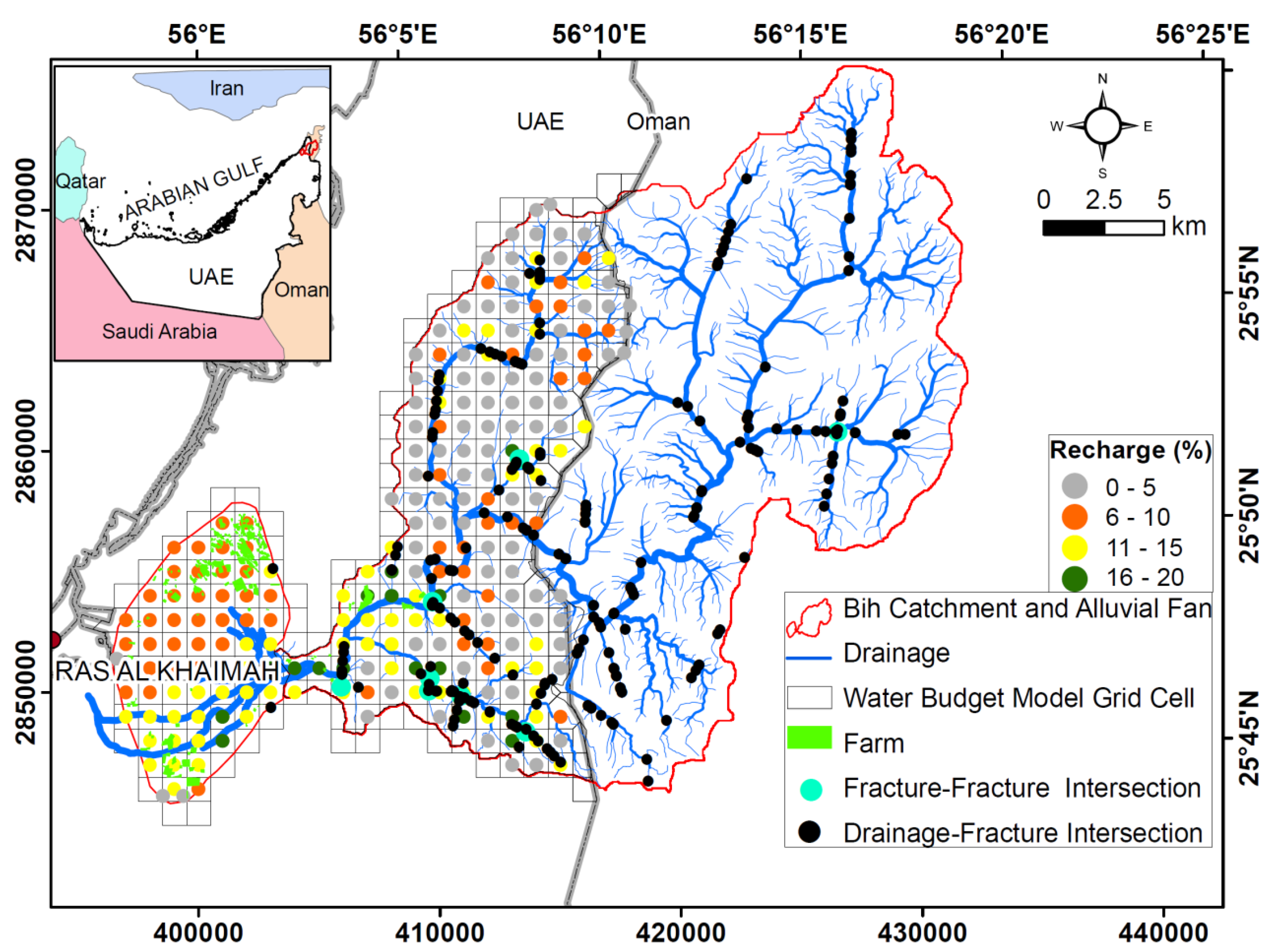


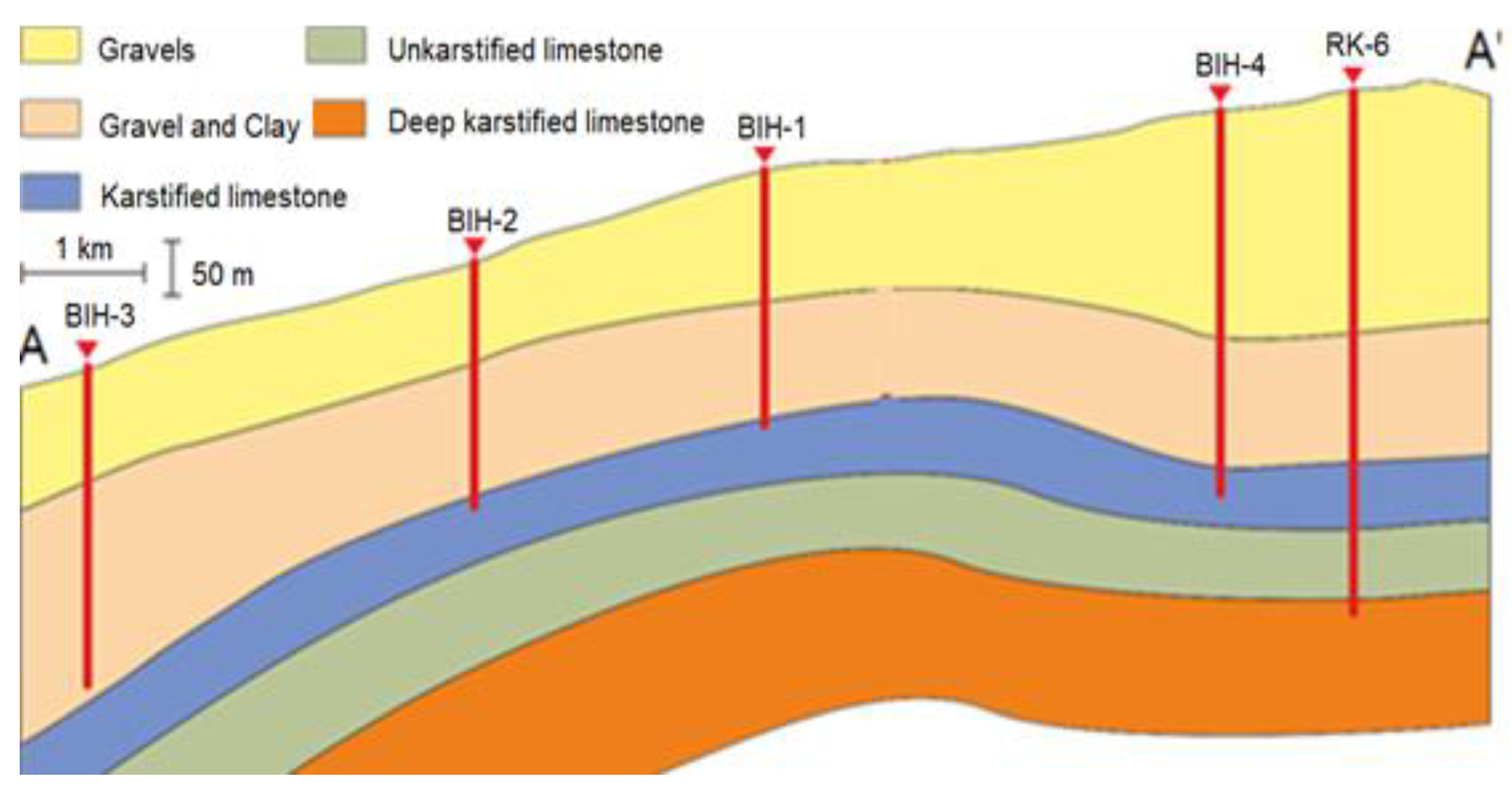

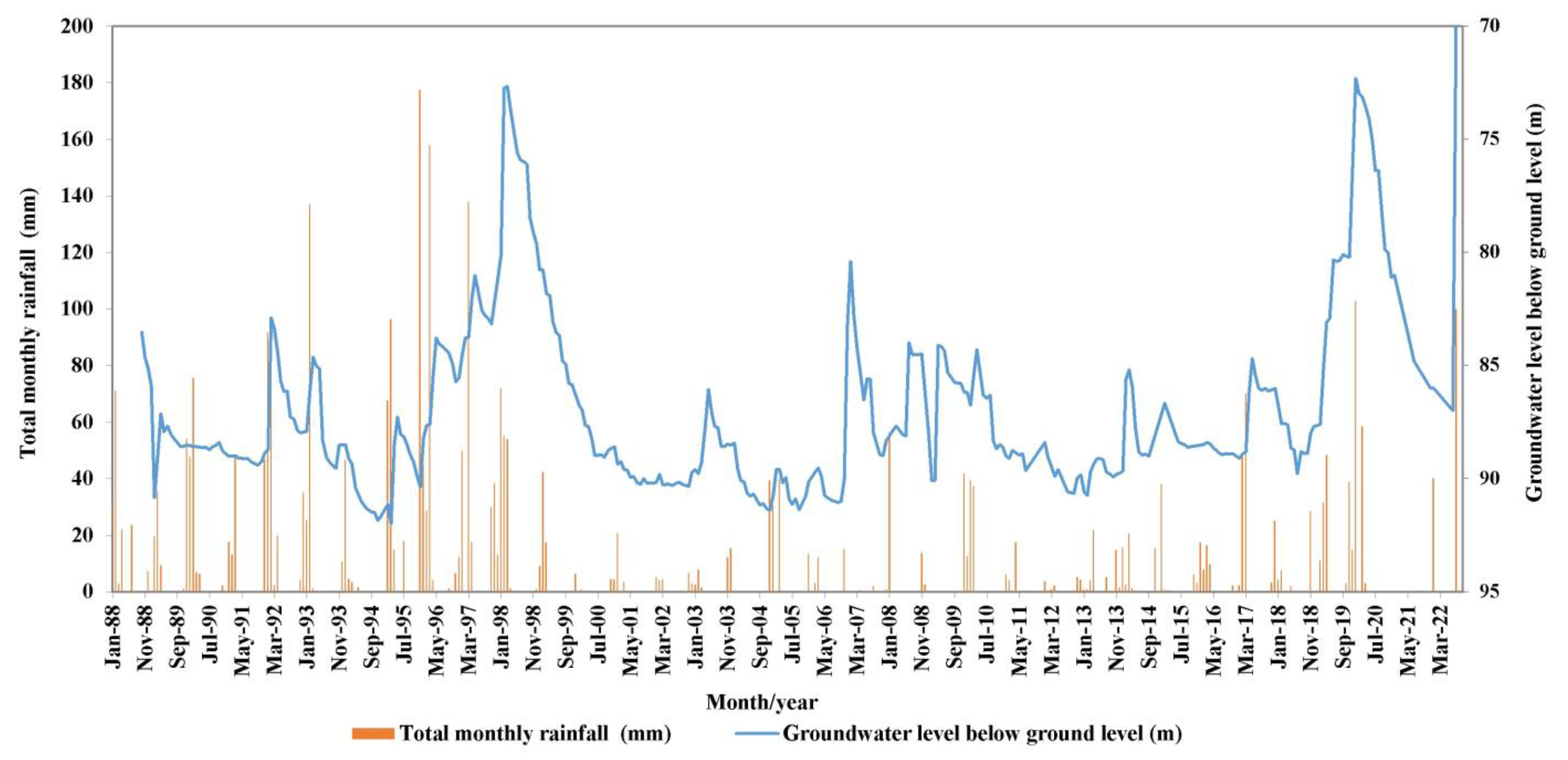
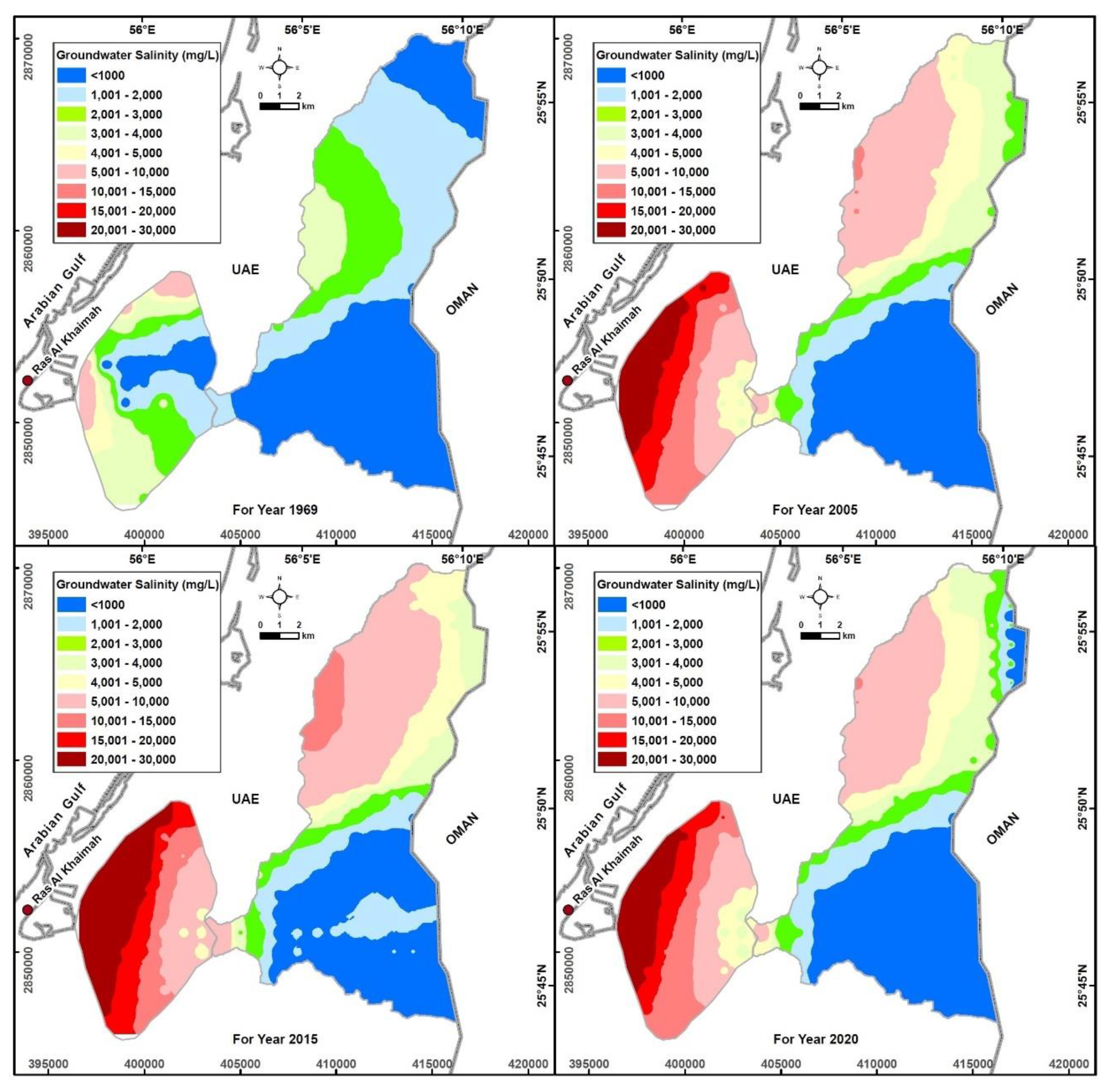
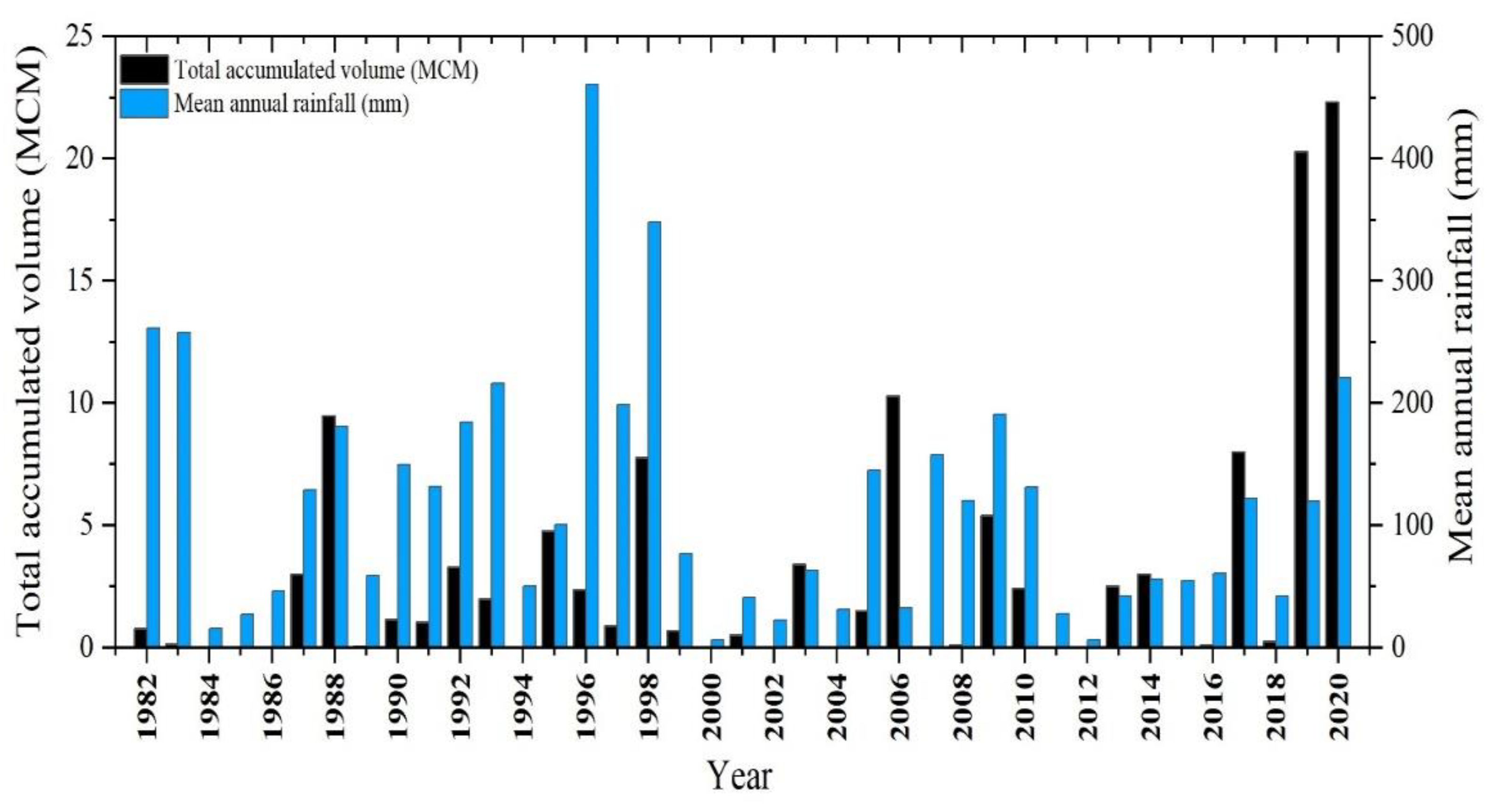

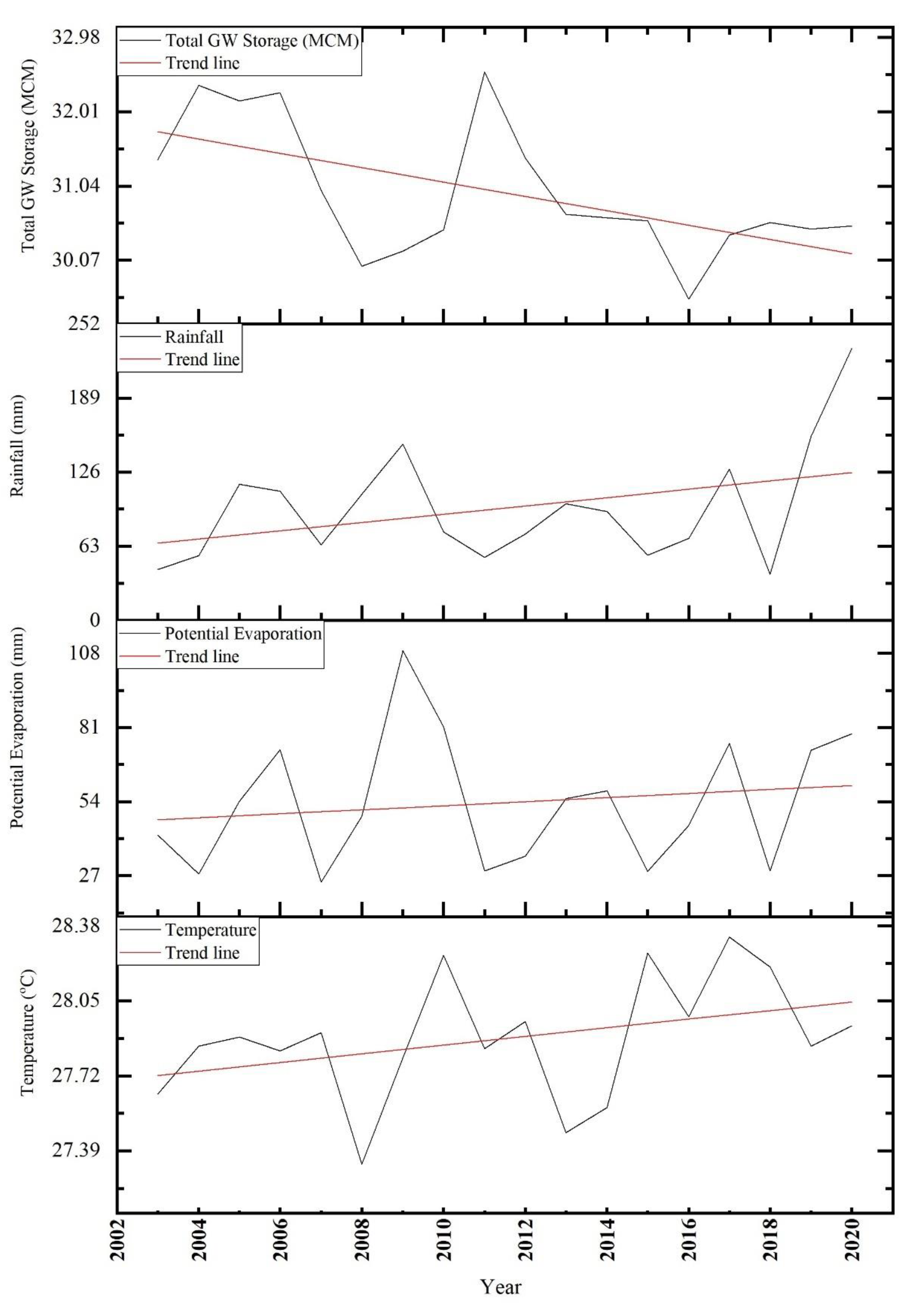
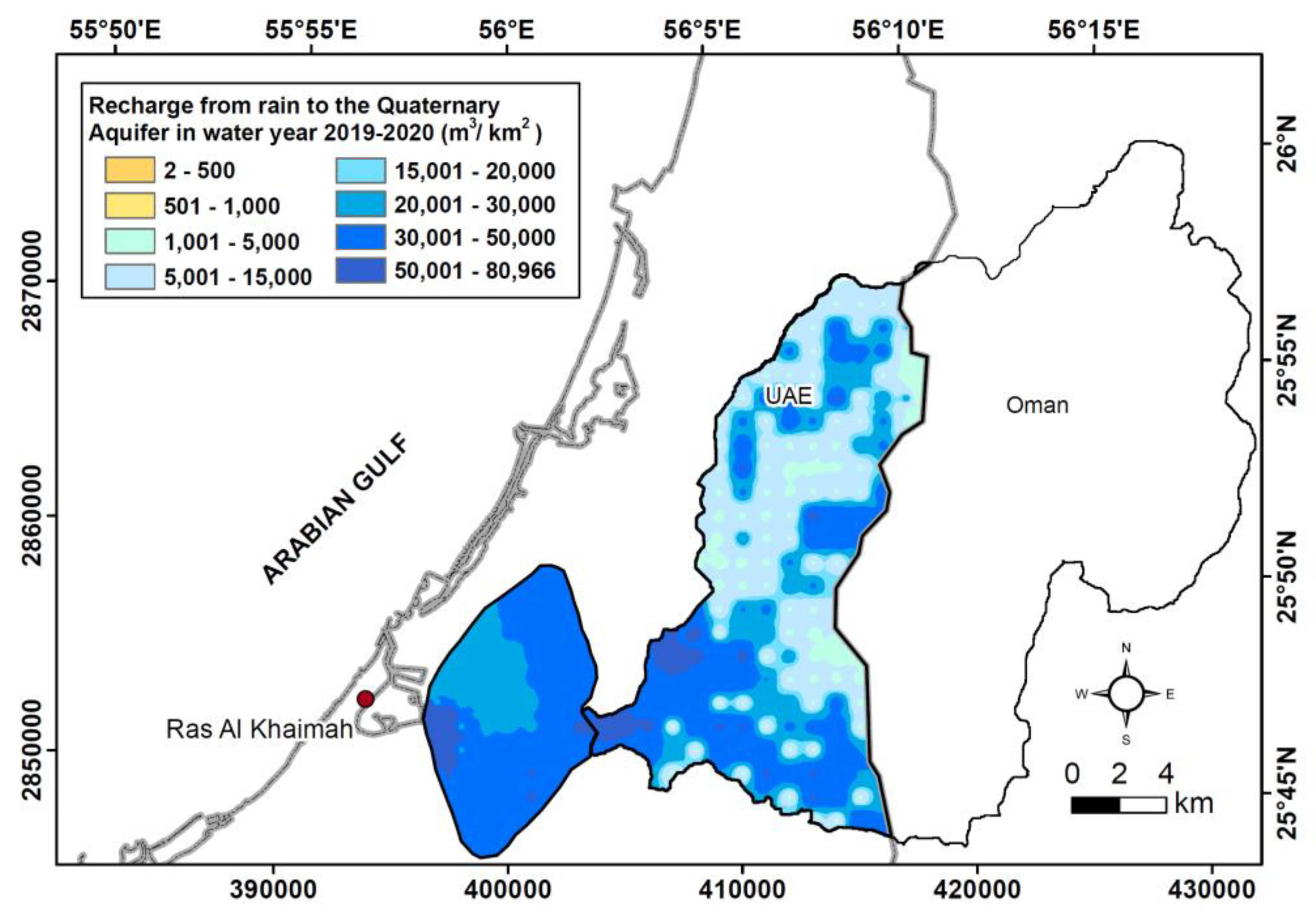
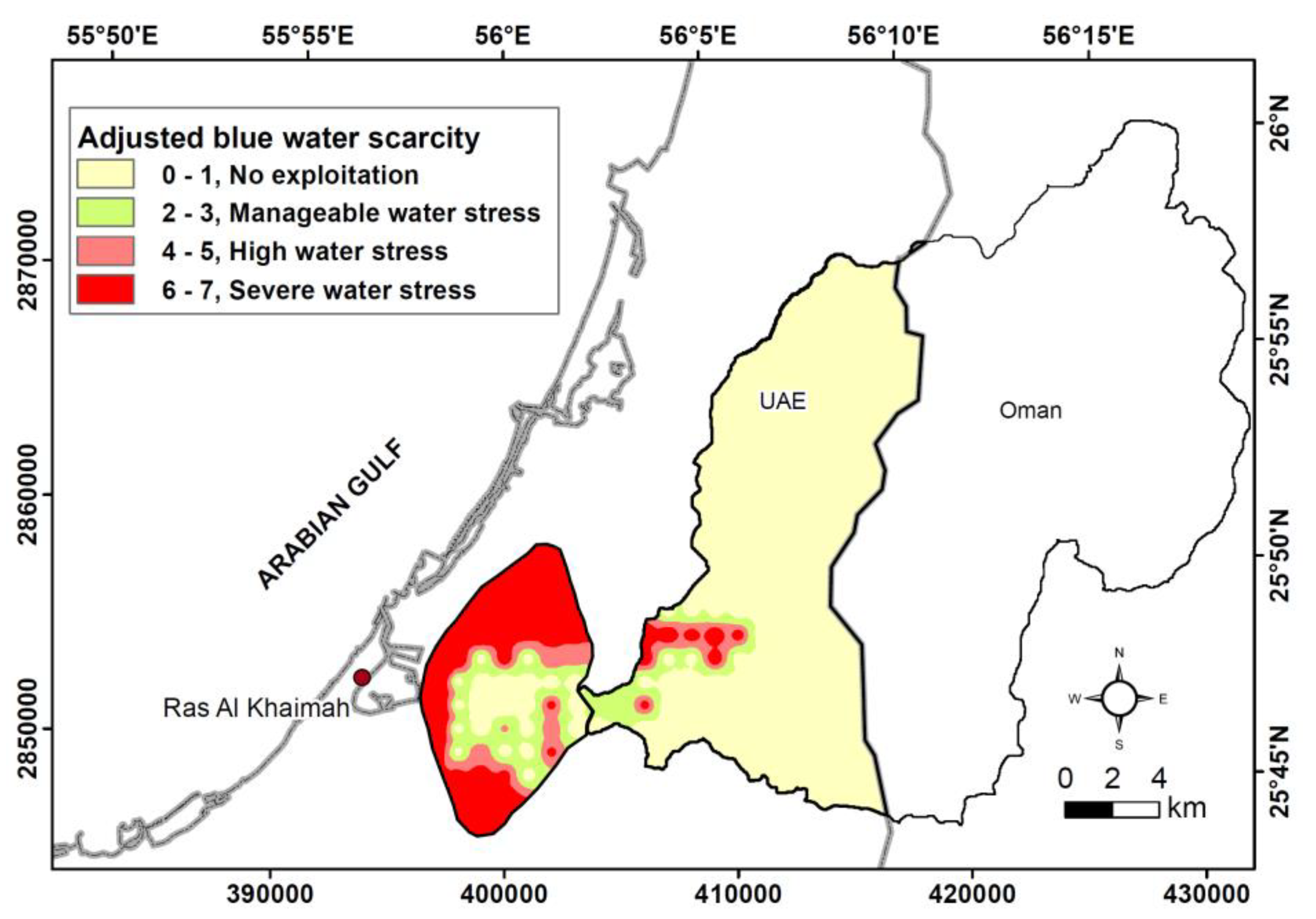

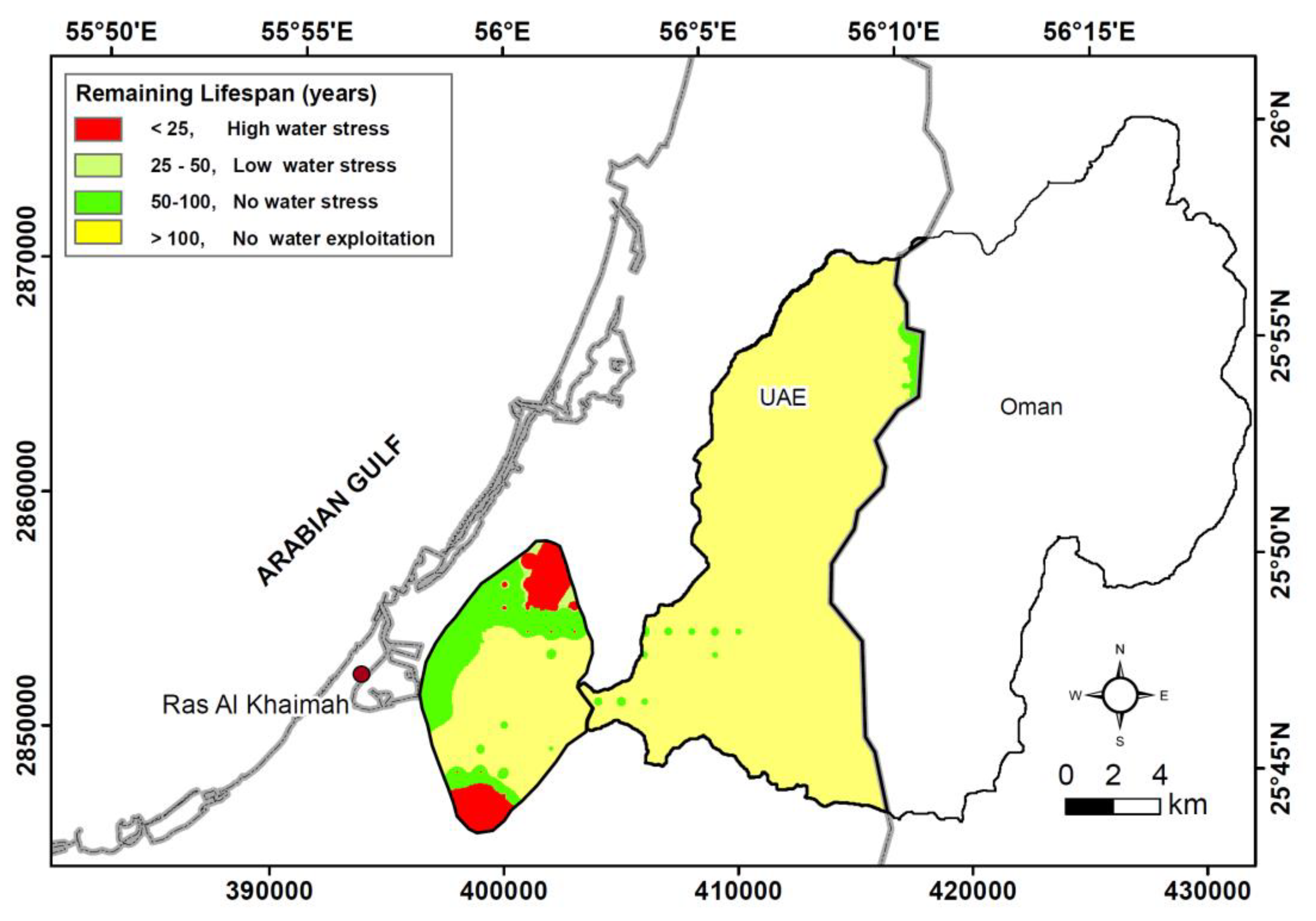
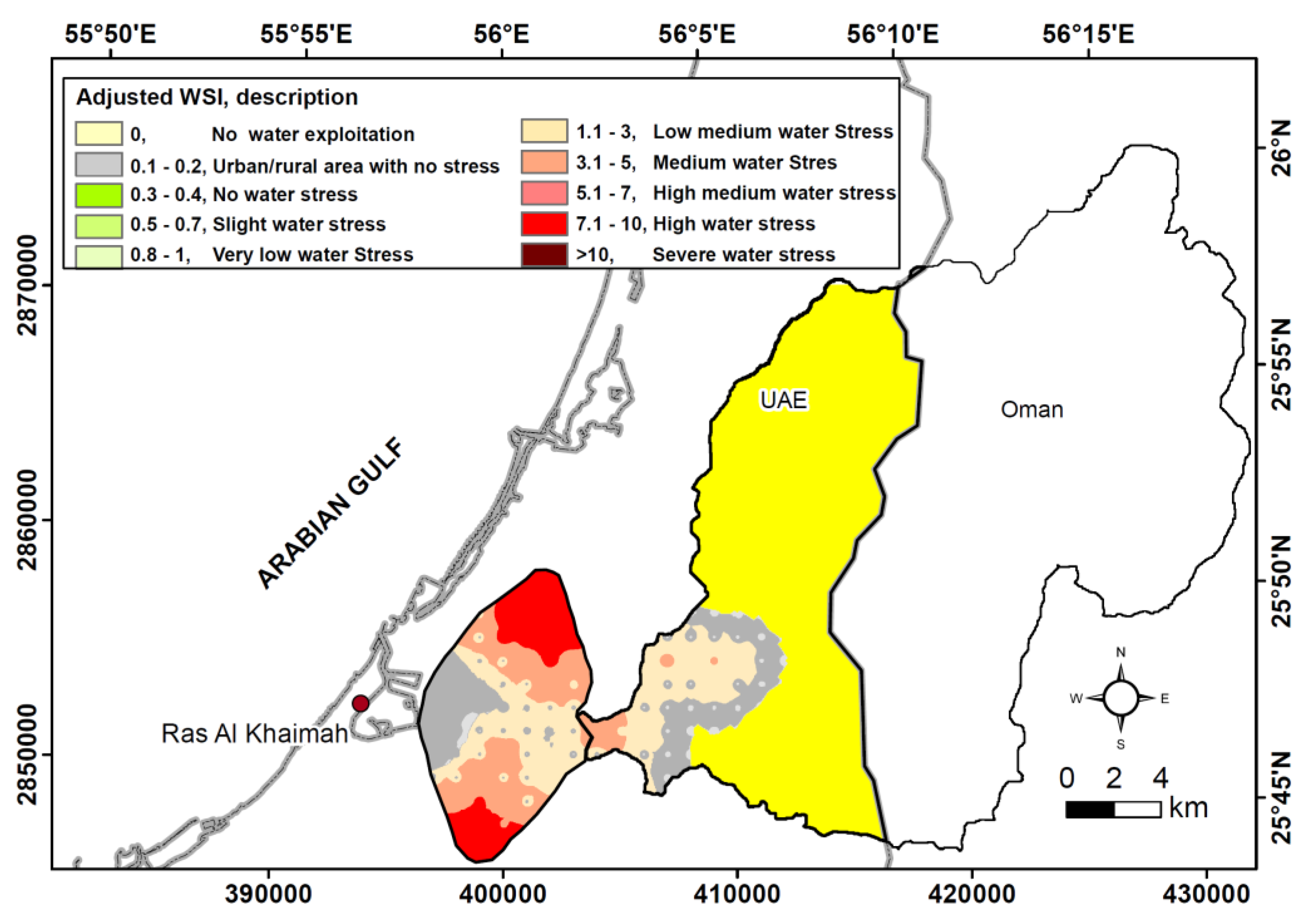
| WHO Water Type | Salinity (mg/L) | 1969 * | 2005 | 2015 | 2020 |
|---|---|---|---|---|---|
| Fresh (MCM) | (<1500) | 2009 | 402 | 322 | 406 |
| Brackish (MCM) | (>1500–20,000) | 2124 | 2326 | 1847 | 1965 |
| Saline (MCM) | (>20,000–65,000) | nil | 541 | 876 | 438 |
| Brine (MCM) | (>65,000) | nil | nil | nil | nil |
| Total (MCM) | 4133 | 3269 | 3045 | 2809 |
| Discharge (MCM/yr.) | UAE Part of the Catchment +Alluvial Fan | UAE Part of the Catchment Only |
|---|---|---|
| Outflow | ||
| Irrigation abstraction | 14.4 | 1.35 |
| Domestic and industrial abstraction | 4.5 (was 12 before 1998) (Going to be ceased in 2026) | 4.5 |
| Evaporation from inland sabkhas | 1 | 0 |
| Groundwater flows across boundaries and toward the sea | 1.5 | 1.5 |
| Subtotal Discharge (MCM/yr.) | 21.4 | 7.35 |
| Input | ||
| Inflow (MCM/yr.) | ||
| Recharge from rain with dam augmentation (Recharge from the rain without dam augmentation) | 8.6 (5.6) | 5.13 (3.3) |
| Inflow across Oman Mountain, above and below mountain gaps using Darcy’s Law | 8.8 | 8.8 |
| Groundwater-fed irrigation return flow | 2.1 | 0.196 |
| Subtotal recharge (with dam augmentation) in MCM/yr. Subtotal recharge (without dam augmentation) in MCM/yr. | 19.5 16.5 | 14.126 12.296 |
Publisher’s Note: MDPI stays neutral with regard to jurisdictional claims in published maps and institutional affiliations. |
© 2022 by the authors. Licensee MDPI, Basel, Switzerland. This article is an open access article distributed under the terms and conditions of the Creative Commons Attribution (CC BY) license (https://creativecommons.org/licenses/by/4.0/).
Share and Cite
Sefelnasr, A.; Ebraheem, A.A.; Faiz, M.A.; Shi, X.; Alghafli, K.; Baig, F.; Al-Rashed, M.; Alshamsi, D.; Ahamed, M.B.; Sherif, M. Enhancement of Groundwater Recharge from Wadi Al Bih Dam, UAE. Water 2022, 14, 3448. https://doi.org/10.3390/w14213448
Sefelnasr A, Ebraheem AA, Faiz MA, Shi X, Alghafli K, Baig F, Al-Rashed M, Alshamsi D, Ahamed MB, Sherif M. Enhancement of Groundwater Recharge from Wadi Al Bih Dam, UAE. Water. 2022; 14(21):3448. https://doi.org/10.3390/w14213448
Chicago/Turabian StyleSefelnasr, Ahmed, Abdel Azim Ebraheem, Muhammad Abrar Faiz, Xiaogang Shi, Khaled Alghafli, Faisal Baig, Muhammad Al-Rashed, Dalal Alshamsi, Munaver Basheer Ahamed, and Mohsen Sherif. 2022. "Enhancement of Groundwater Recharge from Wadi Al Bih Dam, UAE" Water 14, no. 21: 3448. https://doi.org/10.3390/w14213448
APA StyleSefelnasr, A., Ebraheem, A. A., Faiz, M. A., Shi, X., Alghafli, K., Baig, F., Al-Rashed, M., Alshamsi, D., Ahamed, M. B., & Sherif, M. (2022). Enhancement of Groundwater Recharge from Wadi Al Bih Dam, UAE. Water, 14(21), 3448. https://doi.org/10.3390/w14213448






